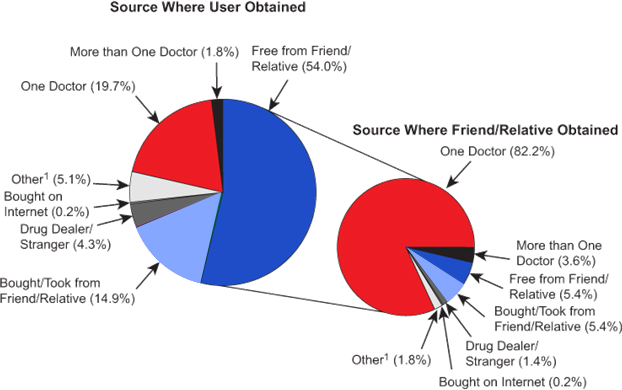Rx Drug Misuse At-a-Glance
Who:
Given the fact that medication misuse statistically rises with age, the earlier we educate children and young people about the realities and dangers of prescription drug misuse, perhaps the better our chances of preventing them from starting to misuse psychotherapeutics in the first place.
- In 2021, 18.7% of people aged 12 or older (or 52.5 million people) used illicit drugs in
the past year. - Among people aged 12 or older in 2021, 3.3% (or 9.2 million people) misused opioids in
the past year. Among the 9.2 million people who misused opioids in the past year, 8.7
million people misused prescription pain relievers and 1.1 million people used heroin. - In 2021, young adults aged 18 to 25 and adults aged 26 or older had higher
percentages of prescription pain reliever misuse in the past year than youths
aged 12 to 17. - About two-fifths of people who misused prescription pain relievers obtained
the pain relievers through prescription(s) or stole pain relievers from a
health care provider.
Source: 2021 National Survey of Drug Use and Health (NSDUH) Releases | CBHSQ Data (samhsa.gov)
What:
While youth and young adult prescription drug misuse is experiencing a slight decline or no significant increase, it is important to continue educating communities on this issue to help ensure that usage rates don’t go up.
- Approximately 6.8 million people or 2.6 percent of the population were nonmedical users of Rx medications, including 4.9 million users of pain relievers, 2.1 million users of tranquilizers, 1.2 million users of stimulants, and 270,000 users of sedatives.
How:
Many teens and young adults are obtaining their medicines from friends or relatives and specific doctors who perhaps are prone to prescribing these medications more often than not. Such realities identify the need for additional education about the hazards of sharing medications, protecting medications from theft and prescribing practices that decrease abuse potential.
- Teens are obtaining medications from family members and friends: More than one-half of the nonmedical users of pain relievers, tranquilizers, stimulants and sedatives aged 12 or older got the prescription drugs they most recently used “from a friend or relative for free.”
- About 4 in 5 of these nonmedical users indicated that their friend or relative had obtained the drugs from one doctor.
Where Pain Relievers Were Obtained for Most Recent Nonmedical Use among Past Year Users Aged 12 or Older: 2011-2012
- Overprescribing: Between 1991 and 2010, prescriptions for stimulants increased from 5 million to nearly 45 million and for opioid analgesics from about 75.5 million to 209.5 million.
- According to the National Center for Injury Prevention and Control (NCIPC), nationally, sales of prescription painkillers per capita have quadrupled since 1999, and the number of fatal poisonings due to prescription painkillers has also quadrupled.
- Prescription painkillers were prescribed in 2010 to medicate every American adult continually for a month.
- Varied motivations for abuse: To get high; counter anxiety, pain or sleep problems; or to enhance cognition.
To obtain more about Rx abuse-related data, visit:
National Survey on Drug Use and Health, 2020
2020 National Survey of Drug Use and Health (NSDUH) Releases | CBHSQ Data (samhsa.gov)
NIDA, Misuse of Prescription Drugs Research Report
Summary of Misuse of Prescription Drugs | National Institute on Drug Abuse (NIDA) (nih.gov)
Robert Wood Johnson Foundation’s Prescription Drug Abuse Strategies to Stop the Epidemic
http://www.rwjf.org/en/blogs/new-public-health/2013/10/new_report_most_sta.html
Robert Wood Johnson Foundation’s Prescription Drug Abuse Strategies to Stop the Epidemic
http://www.rwjf.org/en/blogs/new-public-health/2013/10/new_report_most_sta.html


